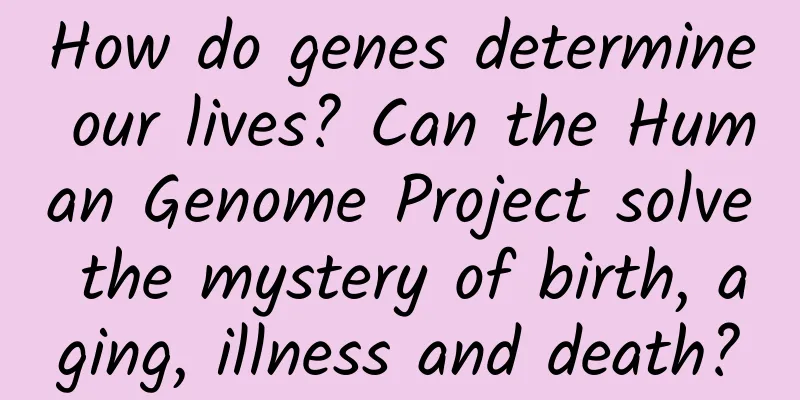How do genes determine our lives? Can the Human Genome Project solve the mystery of birth, aging, illness and death?

|
What determines our life? Genes play a leading role in various life activities, and human beings have never stopped exploring them since they began. A tiny fertilized egg develops into a human body with healthy limbs and a unique appearance, but also goes through similar maturity and aging... It's like there is a detailed instruction manual in our body, guiding the orderly progress of life. This "book of life" is written on the genetic material called DNA. DNA, the full name of "deoxyribonucleic acid", is composed of nucleotide molecules containing different bases. The most important difference in nucleotide molecules is the base. There are 4 types, abbreviated as A, T, C, and G. Among them, A and T, C and G always appear in pairs and complement each other on both sides of the DNA double helix. The order of arrangement of bases is called "sequence". The sequence of DNA is the basis for encoding proteins. The sequence fragment that can encode a complete protein is a "gene". If DNA is compared to a huge library, "gene" is equivalent to the books in it. Figure: The picture comes from Tuchong.com A complete set of DNA sequences is called a "genome". The human genome consists of about 3.055 billion base pairs and contains about 25,000 genes, which can guide the assembly of amino acids in cells into proteins with different functions. For example, hemoglobin in red blood cells can capture oxygen molecules in the blood; keratin can tightly connect with each other to form hard nails. Every human cell has a nearly identical set of DNA, but some genes only work in specific organs or at specific times. Insulin is a hormone that lowers blood sugar and is secreted by the pancreatic beta cells in the pancreas. It is also a protein. When blood sugar rises too high, signal molecules in the blood notify the pancreatic beta cells to open part of the DNA double helix structure, which is the insulin gene, and synthesize insulin protein. Once enough insulin is produced, other signal molecules will notify the pancreatic beta cells to stop the insulin gene from working. It's like you took a book about insulin from the DNA library and put it back after reading it. The similarity of human genomes is as high as 99.9%. The remaining 0.1% of differences and environmental factors together create each person's unique appearance, physique, life span, etc. The DNA sequence will also change during a person's life. Errors in the cell replication process, stimulation from ultraviolet rays, drugs, etc., may cause the loss or positional movement of bases. If this causes gene changes and abnormal proteins are synthesized, it may cause disease. If there is a genome sequence for reference, it is possible to study the causes of individual differences and diseases from the source. Therefore, in 1990, the "Human Genome Project" was officially launched. Its core purpose is to draw a complete sequence map of the human genome, and then study the differences and interrelationships of many genes related to birth, aging, illness and death. The release of the first human genome took nearly 13 years and cost more than 3 billion US dollars. It brought together the efforts of many countries around the world, and China also participated. The sequence data is open to the public for free on the Internet, which has greatly promoted the research and application of the global genetic field. After that, gene sequencing technology began to develop rapidly, and sequencing efficiency continued to increase. Today, the cost of obtaining a single human genome sequence has dropped to about 1,000 US dollars, and the results can be obtained within a few days. In fact, the sequence map obtained in 2003 was not complete, only 92% was completed. Due to technical limitations, some of them failed to be sequenced successfully. You know, if a set of DNA molecules in the human body is fully unfolded, it can be as long as 2 meters, and it naturally cannot be stuffed into a cell with a diameter of only a few microns. In order to save space, DNA molecules are usually coiled and compressed into dense chromosomes and hidden in the cell nucleus. The narrow "centromere" in the middle of the chromosome is the location where the chromosome begins to divide after replication during cell division; the "telomere" at the end of the chromosome, its length becomes shorter year by year with aging. However, the sequences of these two important parts contain a large number of repeated fragments. The sequencer at that time was very inefficient and could only read sequences of only a few hundred bases, and then piece them together piece by piece. It's like playing a jigsaw puzzle. If the puzzle pieces are very small and the colors and shapes of the patterns are very similar, it is difficult to determine their order. After nearly 20 years of exploration, with the help of high-throughput sequencers and sequencing technologies that can read tens of thousands of bases continuously, in 2022, this long-missing 8% was finally unlocked. The new version of the human genome has expanded by approximately 200 million bases and includes 1,956 predicted genes, providing an important basis for studying diseases and analyzing human evolution. No one knows what genetic exploration will bring us in the future and how it will expand the limits of human life and cognition. References |
<<: Why did agriculture and civilization come later than tool making and artificial fire making?
>>: Why is it necessary to develop genetically modified organisms to ensure food security?
Recommend
3 rules for making products, videos and copywriting popular!
In an era where content is king, if you want your...
Three tips for SMS push elements based on the 5W2H method
Here is a summary first. Please scroll to the bot...
The product has attracted new users, how to retain them?
In the past, “born by attracting new customers, d...
Want to be a behind-the-scenes hero of a super project? Learn more about bridge and tunnel engineering!
Reviewer: School of Civil Engineering, Southwest ...
Creating a new lean model: Six most systematic aspects of lean operations
Creating a new lean model: Introduction to the si...
How much does it cost to customize a hardware app in Anyang?
The main factors affecting the price of mini prog...
Tingyun releases 2014 China Network Performance Report
Application Performance Management (APM) is boomi...
How to deploy DOU+ most effectively? Chen Jiangxiong: Douyin DOU+ high-end paid courses Baidu Netdisk (worth 9980)
If you chat with a stranger and say, "Brothe...
How to build a new media operation matrix?
When the number of user groups of a public accoun...
APP product operation user acquisition channels!
Through APP product operation , promotion channel...
Chronic patients don't have to worry about winter! 6 "magic weapons" to warm the body and heart, family members must read
1. Dress like an onion, wrap yourself tightly lay...
How much does it cost to customize a food delivery app in Weihai?
The factors affecting the quotation of customized...
How to run a perfect event?
Just recently, the finals of the official King of...
Data Operations: How to define “user retention” and “activity”?
1. Active Users Let’s first define active users: ...
How can you show off happily without learning some higher-order functions!
[[182412]] If you are new to functional programmi...









